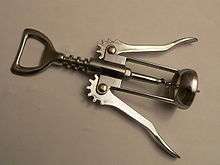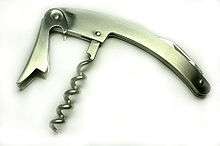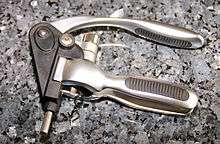Corkscrew

A corkscrew is a tool for drawing corks from wine bottles, beer bottles and other household bottles before the invention of screw caps and Crown corks. In its traditional form, a corkscrew simply consists of a pointed metallic helix (often called the "worm") attached to a handle, which the user screws into the cork and pulls to extract it. Corkscrews are necessary because corks themselves, being small and smooth, are difficult to grip and remove, particularly when inserted fully into an inflexible glass bottle. More recent styles of corkscrew incorporate various systems of levers that further increase the amount of force that can be applied outwards upon the cork, making easier the extraction of difficult corks.
History
Its design may have derived from the gun worm which was a device used by musketmen to remove unspent charges from a musket's barrel in a similar fashion, from at least the early 1630s.[1]
The corkscrew is possibly an English invention, due to the tradition of beer and cider, and Treatise on Cider by John Worlidge in 1676 describes "binning of tightly corked cider bottles on their sides", although the earliest reference to a corkscrew is, "steel worm used for the drawing of Corks out of Bottles" from 1681.[1]
In 1795, the first corkscrew patent was granted to the Reverend Samuell Henshall, in England. The clergyman affixed a simple disk, now known as the Henshall Button, between the worm and the shank. The disk prevents the worm from going too deep into the cork, forces the cork to turn with the turning of the crosspiece, and thus breaks the adhesion between the cork and the neck of the bottle. The disk is designed and manufactured slightly concave on the underside, which compresses the top of the cork and helps keep it from breaking apart.[2]
A person who collects corkscrews is a helixophile.[3][4]
Types
Basic
In its traditional form, a corkscrew is simply a steel screw attached to a perpendicular handle, made of wood or some other material. The user grips the handle and screws the metal point into the cork, until the helix is firmly embedded, then a vertical pull on the corkscrew extracts the cork from the bottle. The handle of the corkscrew allows for a commanding grip to ease removal of the cork.
Wing corkscrew

First invented in 1939, a wing corkscrew, sometimes called a butterfly corkscrew or angel corkscrew, has two levers, one on either side of the worm. As the worm is twisted into the cork, the levers are raised. Pushing down the levers draws the cork from the bottle in one smooth motion. The most common design has a rack and pinion connecting the levers to the body. The head of the central shaft is frequently modified to form a bottle opener, increasing the utility of the device. Corkscrews of this design are particularly popular in household use.[5]
Sommelier knife

A sommelier knife, waiter's friend or wine key is a corkscrew in a folding body similar to a pocket knife. It was conceived by the German Karl Wienke in 1882 and patented in Germany, England, and America.[1]
An arm extends to brace against the lip of the bottle for leverage when removing the cork. Some sommelier knives have two steps on the lever, and often also a bottle opener. A small hinged knife blade is housed in the handle end to be used in cutting the foil wrapping the neck of many wine bottles. A corkscrew of this type can be used more quickly (and with more "show" or panache) than a wing-type corkscrew.
Twin-prong cork puller

Also known as butler's friend or "Ah-So", the twin-prong cork puller can extract a stopper without damaging it, to allow for sampling the wine before re-inserting the stopper. The stopper is removed by pushing the prongs between the cork and the neck of the bottle, and twisting the stopper out of the bottle. Replacing the stopper involves taking it between the two prongs, then twisting it into the bottle and pulling out the prongs.
Lever corkscrew

The lever or "rabbit" corkscrew is operated using a pair of handles which are used to grip the neck of the bottle, and a lever which is simply pressed down to twist the screw into the cork, then lifted to extract the cork. Expelling the cork from the device is done with a similar press/lift action.[6] This style of corkscrew is much bulkier, and typically much more expensive, than other styles, but is much faster.

Mounted Corkscrew
These were invented in the late 1800s for use in homes, hotel bars and restaurants in an era where all bottles were stopped with corks. They are screwed or clamped to counters or walls. When beer began to be sold in bottles, bars required a speedy way to open them. Most early mounted corkscrew were designed to open beer bottles with short corks. Modern ones are made for longer wine corks.[7]
Others
There are many other styles of corkscrew which are not widely used in consumer settings, such as high-priced elaborate devices for specialists, and for industrial uses.
See also
References
- 1 2 3 winepros.com.au. The Oxford Companion to Wine. "corkscrew".
- ↑ "Direct Pull; The Henshall Button". Corkscrew.com. Retrieved 2007-12-10.
- ↑ Quarterly Worme (2000 to present), newsletter of the Canadian Corkscrew Collectors Club, p. 2
- ↑ CorkscrewNet
- ↑ "Corkscrew Put Leverage on Stubborn Stoppers." Popular Science, May 1939, p. 71, bottom of page.
- ↑ Youtube user "Wine Enthusiast" (2009-01-20). "How to Use a Rabbit Corkscrew (Lever Style)". Youtube. Retrieved 2015-02-04.
- ↑ Meadows, Wayne. Compendium of Bar Corkscrews, Vancouver, 2001
External links
| Wikimedia Commons has media related to Corkscrew (tool). |
